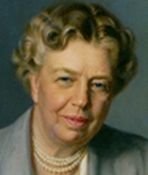 Each year, more than 100,000 North Americans die from medical mistakes. In 1962, newspapers reported that Eleanor Roosevelt may have died because her doctors at one of the most respected medical schools in the world did not diagnose her infection with tuberculosis early enough. She was the wife of Franklin Delano Roosevelt, four-time president of the United States, and was considered "The First Lady of the World."
Each year, more than 100,000 North Americans die from medical mistakes. In 1962, newspapers reported that Eleanor Roosevelt may have died because her doctors at one of the most respected medical schools in the world did not diagnose her infection with tuberculosis early enough. She was the wife of Franklin Delano Roosevelt, four-time president of the United States, and was considered "The First Lady of the World."
Just about every top member of the U.S. government attended her funeral and heard Adlai Stevenson say, "What other single human being has touched and transformed the existence of so many? She would rather light a candle than curse the darkness, and her glow has warmed the world." She was this country’s longest-serving first lady, held her own news conferences, wrote a newspaper column, hosted a radio program and spoke out on just about every issue to support the most benefit for the most people. She was appointed to the first U.S. delegation to the U.N. General Assembly from 1945-1952, and helped draft the Universal Declaration of Human Rights. In her later years, she worked to help disadvantaged Americans.
Her Medical History
In April 1960, 75-year-old Eleanor Roosevelt was correctly diagnosed as having aplastic anemia, a condition in which her marrow stopped making red blood cells. She was so exhausted that she barely had enough energy to get out of bed in the morning. Her doctors found that she had a very low red blood cell count, called anemia. A needle was inserted into the bone marrow in her chest and some of the marrow was removed, which showed that she had aplastic anemia. This disease can kill a patient because the red blood cell counts can drop so low that they cannot carry enough oxygen to supply her brain and she could smother to death.
In September, 1961, her red blood cell count dropped so low that she was given two blood transfusions. She started to bleed because the transfusion failed to replace her platelets, another type of blood cell that prevents bleeding. The doctors prescribed prednisone, a cortisone, to increase the number of platelets in her bloodstream to prevent her from bleeding to death. During the ensuing year, she required several blood transfusions.
On August 3, 1962, she was admitted to the Columbia Presbyterian Hospital in New York City to be treated for a severe cough, night sweats, and fever. The doctors considered that she could be infected with TB, but her chest X ray was normal. On September 26, she was admitted to the hospital for high fever, coughing, feeling very sick and tired, and bleeding from her colon. A chest X ray again was normal and showed no evidence of TB. However, she had excellent physicians who still looked for TB. The diagnosis takes a long time because doctors had to wait many weeks for the TB germ to grow in the laboratory. The doctors cultured her lung mucous for TB and four weeks later, it grew out TB. She started treatment with the standard tuberculosis regimen at that time used throughout the world, of two anti-tuberculous drugs called isoniazid and streptomycin.
On October 2, she was seen by Dr. T Burns Amberson, one of the most respected lung specialists in the world, who doubted that Eleanor Roosevelt had TB because her chest X ray continued to show no evidence of TB. Doctors repeated the bone marrow test to see if tuberculosis was in her bones, but it took four to six weeks more for the germ to grow out from the culture. She was obviously dying. She requested to be discharged from the hospital and allowed to die at home. On October 26, the culture grew out TB and she was definitively diagnosed as having tuberculosis. On November 4, she had a stroke and fell into a coma. She died on November 7, 1962.
Reports of Misdiagnosis
Soon after her death, the whole world was told that the famous and highly respected doctors at Columbia Medical School had missed Eleanor Roosevelt’s diagnosis of TB and treated her with prednisone, which weakened her immunity and caused the TB to spread to cause her death. However, forty years later, a well-researched report by Dr. Barron Lerner showed that there was nothing her doctors could have done to save her (Int J Tuber Lung Dis. 2001;5(12):1080-1085). Samples had been kept and Dr. Lerner was able to show that the tuberculosis germ that was isolated from Eleanor Roosevelt’s body was resistant to streptomycin and isoniazid. No other treatment for TB was available in the 1960s that could have saved her.
October 11, 1884 – November 7, 1962

